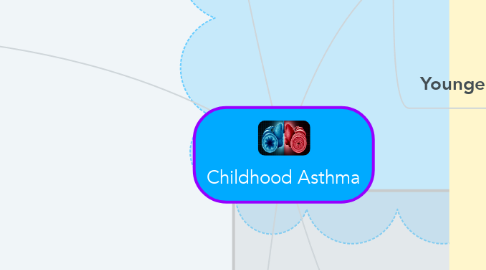
1. General S&S
1.1. Chest constriction
1.2. Nonproductive cough
1.3. Dyspnea
1.4. Prolonged expiration
1.5. Tachycardia
1.6. Tachypnea
1.7. Pulsus paradoxus
1.8. Accessory respirtory use
1.9. Bronchospasm
1.10. Exercise intolerance
1.11. Younger children
1.11.1. Accessory muscle use
1.11.2. Retractions
1.11.3. Head bobbing
1.11.4. Nasal flaring
2. Diagnosis
2.1. Acute
2.1.1. Rapid evaluation
2.1.2. Arterial blood gas
2.1.3. Expiratory flow rate
2.1.4. SpO2
2.1.5. Inspiratory and expiratory wheeze
2.2. Chronic
2.2.1. Frequency of wheezing episodes
2.2.2. Evaluation of risk factors
2.2.2.1. API
2.2.2.2. Genetic
2.2.2.3. Existing allergies
2.2.3. Confirm with pulm function tests
2.2.3.1. Empirical tx in young children
3. Management
3.1. Acute
3.1.1. Oxygen
3.1.2. Bronchodilators
3.1.2.1. SABA
3.1.2.2. Anticholinergics
3.1.2.3. IV Magnesium sulfate
3.1.2.3.1. Severe cases
3.1.2.4. Mechanical ventilation
3.1.3. Short acting medications
3.1.4. Anti-inflammatory agent
3.1.4.1. Systemic Glucocorticoids
3.2. Chronic
3.2.1. Stepwise approach
3.2.1.1. Drug classes stepped up or down as needed - steps in relation to severity
3.2.2. Allergen avoidance
4. Characteristics
4.1. Definition
4.1.1. Status asthmaticus
4.1.2. Bronchospasm not responsive to treatment
4.1.3. Progressive Airway obstruction
4.1.3.1. Air trapping
4.1.4. Decreased ventilation
4.1.5. Life-threatening
4.2. Causes
4.2.1. Exposure to allergens or irritants
4.2.2. Late treatment of a chronic exacerbation
4.2.3. Viral or bacterial respiratory infections
4.3. Risk factors
4.3.1. Age
4.3.1.1. Young children may not report symptoms
4.3.2. Inadequate treatment
4.3.3. Level of exposure to irritants
4.3.4. Genetics
4.3.5. Socioeconomic level
4.3.6. Black, Alaskan Native, American Indian, Hispanic
4.3.7. Female gender after puberty
4.3.8. Preschool or younger
4.3.8.1. Under diagnosed
4.3.8.2. Smaller airways
5. Complications
5.1. Acute
5.1.1. Life-threatening
5.1.2. Silent chest - no audible breath sounds
5.1.2.1. Impending death
5.2. Chronic
5.2.1. Hyperinflation
5.2.1.1. Thorax or pectus excavatum
5.2.2. Exercise intolerance
